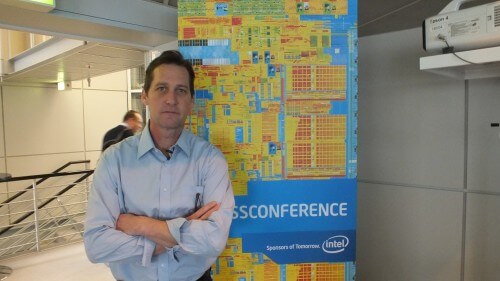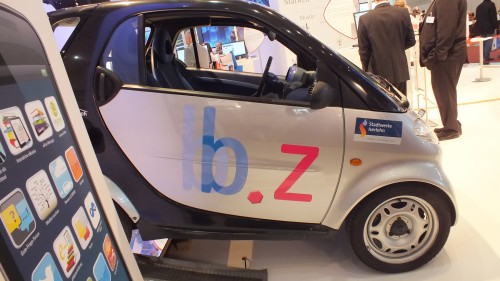Eighty million cars join the roads every year. The rate of urbanization is increasing. In a few years there will be autonomous cars, semi-autonomous cars and manually driven cars on the roads

Intel also has a vision for smart transportation, but not necessarily in that every vehicle will be completely autonomous, independent of the environment, as Google does. Intel, on the other hand, takes the approach of a comprehensive transportation solution," says Tim Plowmin, Senior Research Scientist at Intel Laboratories in Santa Clara, in a conversation with CHIPORTAL California who participated in a press briefing as part of the Svit 2013 exhibition that ended on Saturday in Hanover, Germany.
"Intel conducted a study with the aim of understanding what experiences it can provide for a world that will contain 1.5 billion cars. The car companies understand that technology is important. My team in the laboratory insists on improvements both in the car itself and in the transportation industry as a whole. In my group we use several methodologies to attack the transportation problem. We have experts in various fields, among others for perceptual learning, construction planning, optimization. I personally have a doctorate in anthropology, and we also have psychologists and experts in human behavior on the team, and of course, engineers.
We aim to reach perceptual computing. Already today we use many means such as touch screens that changed the way we communicate with computers, a facial recognition system that will solve us from the need to remember passwords and more. All of these need processing power. The ultimate goal is that when you communicate with a computer, you won't know if it's a computer or a person. This child takes many years, even though he was born with tons of neurons. We expect a computer to understand us immediately. Therefore, it should be given enough performance for them to do so."
"In the last year, we conducted a qualitative study among car owners in several countries with different characteristics: Australia, China, Brazil and the USA under the title LOCAL EXPERIENCES OF AUTOMOBILITY. We interviewed dozens of car owners and examined their behavior as drivers" By the way, one of the photos Plomin showed in the slide was of equipment taken out of the trunk of a driver in the USA: the items he leaves in the car testify to the owner's driving experience," he said.
"Cars are transitional spaces. They are spaces that allow everyone to move from point to point and also in terms of your life. There is always technology inside the car. One of the challenges is to combine the technological platforms and the enormous ability of the cloud to integrate together with the technologies inside the car and the communication between the cars to bring us to a different driving experience:
"The car usage rate is very low 90% of the time the car is parked. This is a low usage ratio for something that is very expensive both to purchase and to maintain (mainly the insurance costs) to think about what can be done if 90% of the time is not used, maybe car sharing"

"Another area that needs to be paid attention to is the fact that over 70% of the trips are routine - to the same place, at the same time. What this means not only in terms of how the car understands your behavior and your routine but also collectively if 70% of users perform the same action, maybe the overall traffic can be better managed, not just the individual vehicle. Also to manage the environmental impacts. This is the concept of Intel's COOPERATIVE DRIVING. Google has a different vision: that you don't even have to be in the car for it to drive and it doesn't have to collaborate with anyone else. Google's car does not work well in snow, nor in heavy rain because of the technology that constantly photographs the environment from the roof. Google's approach is to throw away a large amount of computers - they have a Zion server and in general they invested $70 worth of technology in each car. The right way is cooperative driving, we must take care of the connection between vehicles, so that the cars will be more automatic in terms of their driving. These are some things that emerged from the research that should be thought about. There is a lot of opportunity in this area and much of the understanding comes from the basic research we did."
An interesting statistic we learned in the research is that in places such as Beijing, where about 80% of the car owners who purchase them in any given year do so for the first time in their lives, so that they can adapt to new technologies and set an example for the rest of the world," Plomin concludes.

4 תגובות
Anyone who has abused you can create a chain reaction of nanotechnology that creates as many little people as possible stuck inside atoms with mini ovens for billions of years
Everything is acceptable - if there was efficient mass transportation (in the country) people would still travel by car.
Even if there was a transporter people would still travel in cars.
As there are still people in the world (a lot) who use horses as a means of transportation - the farther away you go from being animated, the more you go back in time.
So I didn't understand there is a product for Intel or are they busy with grandiose world plans and giving us advice?
It's good that they have money for R&D how to fix the world or at least pretend to present an alternative to what Google is trying to do.
The difference between finding a transportation solution that will serve the general public and developing a car is huge.
It is not at all certain that the transportation solution that will serve the public well is private cars.
It is very possible that public transportation is the solution.
If public transportation will be cheap, fast, accessible, and reach everywhere, then there is no reason for anyone to buy a private car.
samomon
What do they do in technology or mass psychology? You provide transportation for your employees, so maybe this model is suitable for everyone? And say thank you that Google buys Zion and not AMD